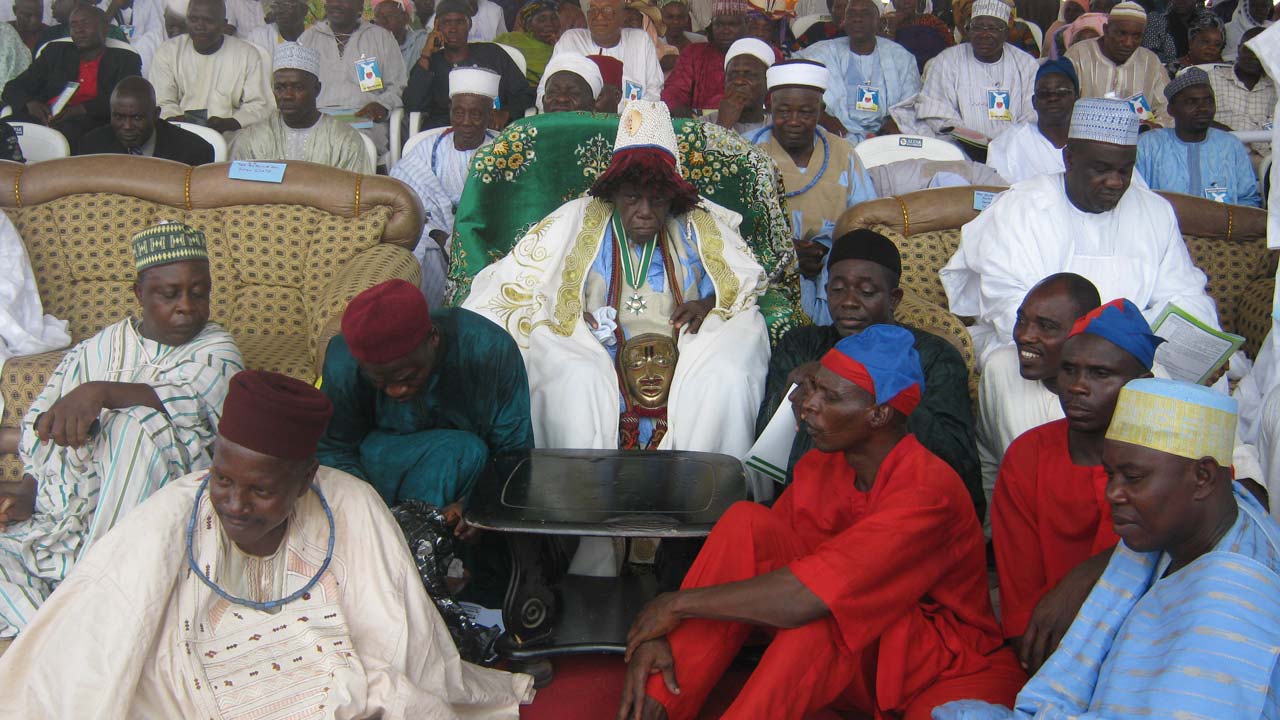Origin, Descent and Ascent
A capsulized synopsis of the Igala origin and descent was written by one native as; From the Tower of Babel>Egypt>Sudan>Ethiopia>Congo>Borno state>Taraba state/kwararafa (Wukari)>Abejukolo-efe, Kogi State (Omagede Otutubatu )>IGALA MELA-Idah in same Kogi State and then scattered all over Nigeria, including those of Olu areas in Anambra state (Ijam, Odekpe, inoma Akator, owele, Igbokenyi, Olumbanasa); Ebu in Delta state; Ifeku, odogume, illushi,inyelen all in Edo state & those in Ojor, Ogurugu, Igah, Asaba and Enugu state.
Another submission is that, the Igala tribe has an intertwined historicity and ancestry with the Igbos. It is narrated that Eri who is said to have migrated from southern Egypt through the Igala area, settled, and established a community in the middle of Anambra river valley (at Eri-aka) in Aguleri where he married two wives. The first wife, Nneamakụ, bore him five children. The first was Agulu, the founder of
Agulu (The ancestral head of Eri Kingdom clans) (the Ezeora dynasty that has produced 34 kings till date in Enugwu Aguleri), the second was Menri, the founder of Umunri / Kingdom of Nri, followed by Onugu, the founder of Igbariam and Ogbodulu, the founder of Amanuke.
The fifth one was a daughter called Iguedo, who is said to have borne the founders of Nteje, and Awkuzu, Ogbunike, Umuleri, Nando, and Ogboli in Onitsha. As one of the children of Eri, Menri migrated from Aguleri, which was and still is, the ancestral temple of the entire Umu-Eri (Umu-Eri and Umu-Nri). His second wife Oboli begot Ọnọja, the only son who founded the Igala Kingdom in Kogi State.
Well, whichever of the narration seems most plausible, a clear fact is that, the Igala are an ethnic group of Nigeria, presently situated in the triangular area of about 14,000 km2 in the angle formed by the Benue and Niger rivers; and also extending across the Niger in Lokoja, Kogi state of Nigeria. The homeland of the Igala Kingdom is in Kogi state and has its capital at Idah.
Religious Inclinations and Traditional Attire of the Igala Tribe
The Igala people believe in the supremacy of Ojo Ogbekwugbekwu (God Almighty). They also worship the deities of their ancestors with diligence. River gods and goddesses are celebrated among others during special festivals. In addition, the Igala people also believes in the existence of Ilei (this world) and Oj’ona (the afterworld). The Oj’ona is the world of the ancestors and it is also believed that the Oj’ona is a continuation of ilei. This implies that some Igalas are highly syncretic.
As regards the traditional attire of the Igalas, emphasis is put more on the colour than on the style. The traditional colours are Black and Yellow; the Black colour signifying the richness of Igala land; the wealth in terms of minerals, crude oil, and fertility of the land. Black colour also symbolizes prosperity and wealth for Igala people. Yellow colour on the other hand signifies the hospitable nature of the tribe. It also represents gold as a symbol of prosperity and richness.
Marriage Ceremony in Igala Land
After the espousal and courtship, the first major step in conducting marriages amongst the Igalas is the Introduction process. The introduction is done in three phases namely; the introduction of her paternal family, that of her maternal family and the lady’s introduction. The introduction of the paternal and maternal family is technically the same, the only difference is just the name.
On the day of the marriage, the two families and their loved ones assemble to witness the matrimonial bonding. In accordance with the marriage rites, a mat is laid and a new wrapper spread on the mat. The bride will then come in the group of her friends. This is process is repeated but with a change of cloth and fewer friends. In the later, the bride and her friends are requested to sit on the mat, but they will exhibit a refusal, giving a seemingly plausible reason. The ‘antidote’ to this inability to sit is the continuous spraying of money by the groom’s family till the bride deems it appropriate to sit.
This is then followed by the presentation of kola nut, bride price, drinks etc. by the groom’s family through their spokesperson, and a request for the girl’s hand in marriage. The bride’s family in turn will seek her consent on acceptance or refusal of the gifts. An acceptance affirms an intention for the marriage to be contracted. The bride’s family subsequently gives admonitions and exhortations to the groom as regards her welfare; feeding, clothing, and health of their daughter will be their responsibility henceforth. There is strong counsel against domestic violence and divorce amongst the Igalas.
The Paramount ruler of the Igala ethnic group is known as the ‘Attah Igala’. The term, ‘Attah’ means ‘Father’ and therefore, the full title of the ruler, ‘Attah Igala’, means, ‘the Father of Igalas’. Attah Ayegba Oma Idoko and Attah Ameh Oboni are two of the most revered Attahs of the Igala kingdom. Legend has it that Attah Ayegba Oma Idoko offered his most beloved daughter, Princess Inikpi by burying her alive to ensure that the Igalas win a war of liberation from the Jukuns’ dominance. Princess Inikpi statute presently stands with grace at Idah (Igala nation headquarter). She is ever pointed as a heroine.
References
Fidelis Eleojo Egbunu (2001), Be Not Afraid, Only Believe: Christian Remedy to Fear of Spirits: the Igala Case. Snaap Press.
Obaro Ikime (1980), Groundwork of Nigerian history. Heinemann Educational Books, for the Historical Society of Nigeria.
J.S. Boston (1968). The Igala Kingdom. Ibadan: OUP
Tokula, Lillian (2008). Re-Duplicaton in Igala: An Autosegmental Approach. Masters thesis, Department of Linguistics, University of Ibadan, Nigeria.
Featured image source: The Guardian Nigeria


